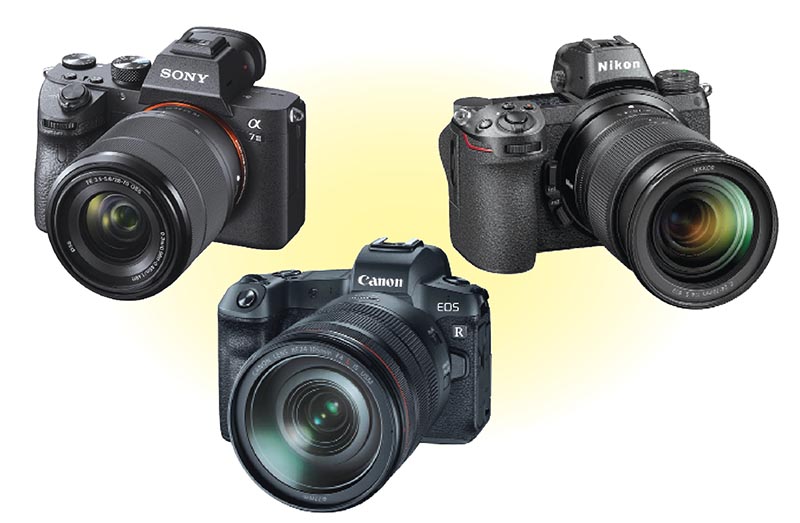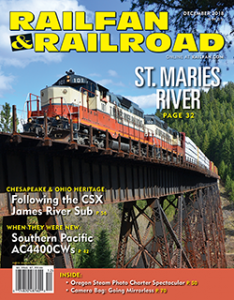When the first commercial railways were constructed 200 years ago, the application of metal wheels on metal rails was a great leap forward from millennia-old methods of muscle, wind, and water power. It forever changed the world in which we live; a most gracious gift to civilization from its first developers in the United Kingdom.
One constant of technology is change. Ever since the invention of the wheel itself, technology has inexorably evolved. It cannot be stopped, and as much as we miss the familiar and distrust the new, in the long run advancing technology serves us and makes our lives better.
As railfans, we pursue our passion for railroading in many ways. As much as we revel in examining the change of the railroad locomotive from the earliest steam to the latest diesel, I wager the favorite tool that we use to interact with and record our railfan experience gets far less attention.
Just like our beloved trains, the camera has also evolved. Almost as old as railroading itself, it has proven mutable from the first wooden boxes and glass negatives, to folding cameras with roll film, to the modern 35mm single lens reflex camera, to today’s digital SLR models. What is happening now in the camera world is that we are on the cusp of an evolution to the next basic form, one that works a bit differently. To understand how differently, let’s look a little into the history of cameras.
Where We Were
Since their invention in the 1830s, cameras have required the user to either look through the rear of the camera before inserting the emulsion or use a viewfinder that could only approximate what the camera was seeing. However, with the invention of the SLR in the 20th century, the photographer had for the first time the ability to see exactly what the camera was seeing right up to the moment of exposure.
The basic principle of the SLR has a mirror placed at a 45-degree angle behind the lens and before the film. All the light from the lens is sent up to a glass plate viewfinder. This not only allows viewing of what the camera sees, but allows focus to be set as well by moving the lens back and forth until the image is clear. When you press the shutter, the mirror flips up and out of the way of the film. Early SLR cameras had two drawbacks. First, the image was flipped left to right, which makes composition a challenge. Second, when you tripped the shutter, the camera viewfinder would black out. You would not see an image again until you manually lowered the mirror. The well-known medium-format Hasselblad works exactly the same way.
It may surprise you that such a camera was available in the ’teens, and by the 1930s, the inimitable Lucius Beebe was using the Graflex Model B camera — a 4″x5″ sheet film SLR beast of wood, leather, steel, and glass — to make the stunning wedgies in his books.
In 1938, Germany’s Practica made the Exakta, the first 35mm SLR camera. This camera created the path to the introduction of the sensational Nikon F in 1959, which firmly established the 35mm SLR as the prevailing camera for amateur and professional photographers alike for decades.
The modern SLR/DSLR (digital SLR) mirror sends the light up into a pentaprism that sends the image, right side up and correct left to right, out the viewfinder to the eye. (When I set focus by looking at the ground glass and moving the lens focus ring for the first time in 1967 with my father’s Pentax Spotmatic, it was a revelation!) When the shutter is pressed there is a blackout, but on most modern SLRs the mirror has an instant return, which is much better. Still, for anyone used to viewfinder cameras and no blackout, it takes a while to get used to.
As film transitioned to digital the mirror was retained, and it gave good service for the first 15 years or so of DSLR development. Due to advancements in digital photography, with particular attention to the electronic viewfinder (EVF), the dependence on the mirror is fading. The image can be sent directly to the EVF or the rear screen without need of a mirror. This opens up valuable advantages.

Current popular models of mirrorless digital cameras with interchangable lenses include the Sony Alpha 7 (left), the Canon EOS R (middle), and the Nikon Z6 (right).
Where We’re Going
Ever since the advent of the mirror, designers have been hampered by having to create lenses, particularly wide angle ones, around the fact that extra distance was needed from the image plane because of the flipping mirror. This led to compromises since lenses could not be situated in the ideal position. They had to design what are known as “retro focus” lenses that essentially folded the lens in on itself to make room for the mirror. This led to slower apertures, chromatic aberration (or “CA,” which is misaligned color on the lens’ periphery), increasingly complex lens elements, and of course, greater expense.
The new mirrorless camera bodies and their lenses dispense with all that. Now lens designers are free to make more ideal designs allowing faster apertures, the virtual elimination of CA, and less-complicated glass elements. In some of the new lenses, the biggest piece of glass is not in the front anymore but in the rear of the lens. This, as you might imagine, moves the center of gravity back toward the body, resulting in a better, more comfortable balance while holding the camera…




